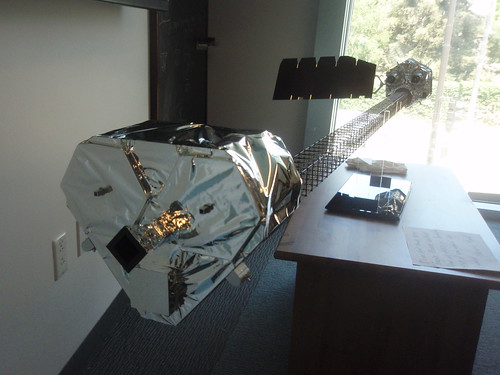Try on a pair of NuSTARs!
- By Daniel Wik
- February 26, 2013
- Comments Off on Try on a pair of NuSTARs!
Sara’s note: Please join us in welcoming our newest guest blogger, Dr. Dan Wik! You might have heard our interview with Dan in our podcast NASA’s Newest X-Ray Eyes, and we’re excited to get more behind-the-scenes coverage of NuSTAR and Dan’s research in his blog posts.
Imagine you are usually confined inside your home – like we are on the surface of the Earth – but when you do make it outside at night, you forget your glasses despite having terrible vision. Looking up at the sky, you can see a few blurry stars and a diffuse glow, but you can’t tell if the glow is really diffuse or just made up of many fainter stars. Next time you make it outside, you resolve to remember your glasses to find out. If the light is coming from the X-ray part of the spectrum, then on the next trip outside you’ll be wearing a pair of NuSTARs.
NuSTAR is the first observatory capable of focusing the bluest colors of X-ray light, in a bandwidth where the X-ray sky is the brightest. Since its launch last summer, it has been surveying the sky in order to detect the source of this glow, which is thought to be made up of many discrete objects. These are not stars, but massive black holes in the hearts of galaxies billions of light years away. In fact, we’ve already resolved the redder part of the X-ray sky with the Chandra X-ray Observatory, which is how we know what these objects are. However, the kind of black holes we see with Chandra cannot produce the light at the bluest end of the X-ray spectrum. We still think they’re massive black holes, but there’s something intrinsically different about them. Once we find them with NuSTAR, we’ll learn exactly why they’re different and what that means for the growth of black holes over cosmic time. These massive black holes at the centers of galaxies – millions of times more massive than the Sun – appear to grow as the galaxy around them grows and changes, a process that depends on their galactic neighborhoods and the larger cosmic web — seeded just after the Big Bang — in which all galaxies are ensnared.

A model of NuSTAR at Caltech. The part closest to the camera holds the mirrors (the two “eyes” – looks remarkably like a face), and the detectors and rest of the spacecraft are on the far end of the boom. Credit: Caltech/JPL/NASA
But this is hardly the only mystery NuSTAR will shed light on. In addition to understanding the black hole at the center of our own Milky Way galaxy, we’re investigating other black holes in our galaxy and other galaxies, like the ones in the galaxy IC 342, NGC 253, and many others. Black holes aren’t the only targets though. The unprecedented resolving power of NuSTAR allows us to image large, extended objects like supernova remnants such as Cassiopeia and even the diffuse gas in clusters of galaxies. This last type of object is the one I’m most interested in; I’m currently analyzing our observation of the first galaxy cluster imaged by NuSTAR, the so-called Bullet Cluster.
In a future post, I’ll talk exclusively about what we’re learning about the Bullet Cluster, a unique galaxy cluster that also proves that dark matter is real and not just a misunderstanding of the laws of gravity. And keep your eyes peeled for the first NuSTAR science publication and press release on a rapidly spinning black hole, which should be out any day now. Until then, ask a question in the comments, and I’ll do my best to answer it for you!


